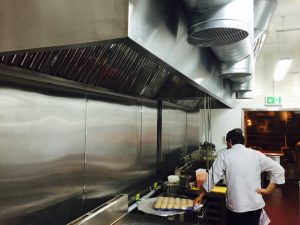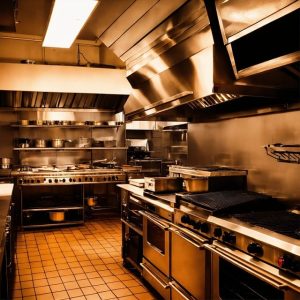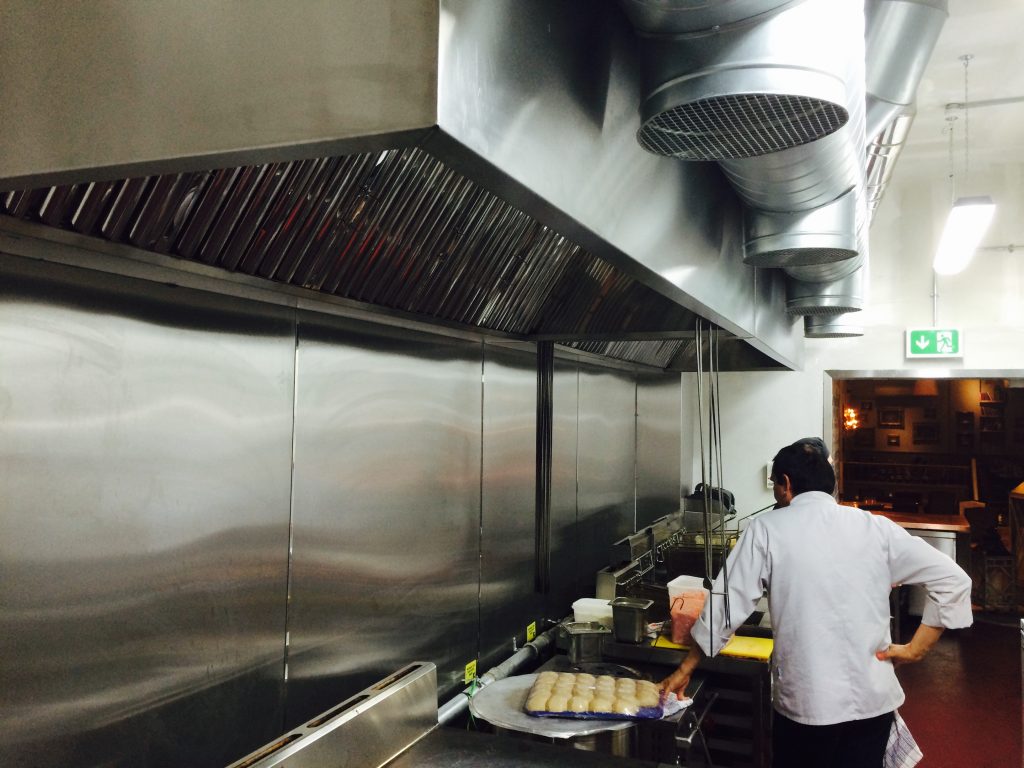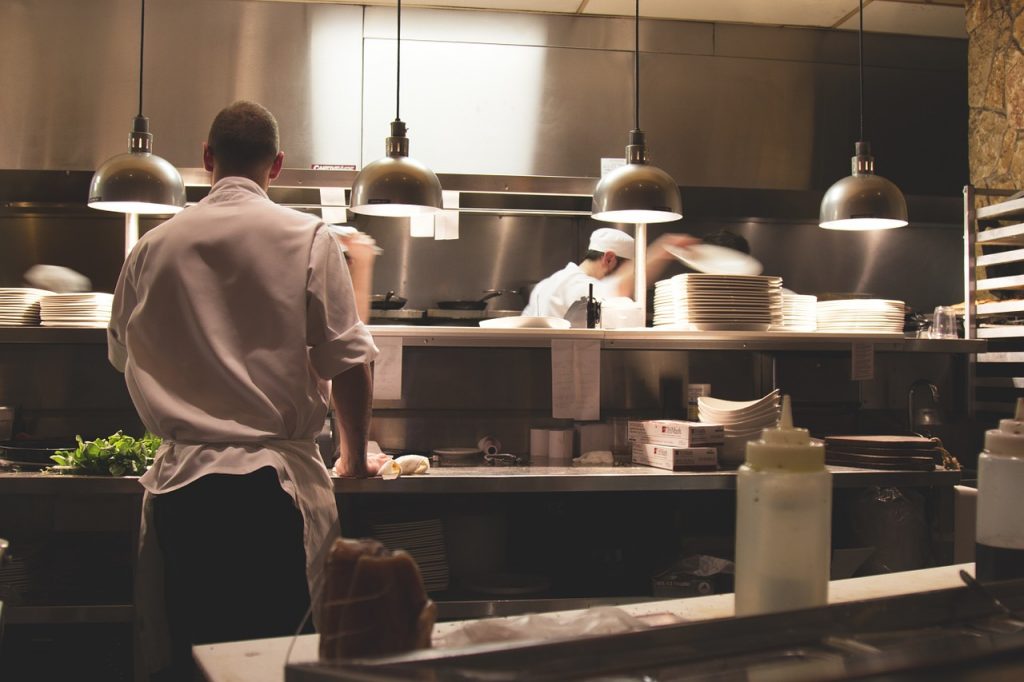Commercial Ventilation Hood
 This is often referred to as a commercial kitchen hood or exhaust hood and is an essential piece of equipment used in commercial kitchens and food service establishments. Its primary purpose is to remove heat, smoke, steam, grease, and odours generated during cooking processes. These hoods are designed to maintain a safe and comfortable environment in the kitchen and ensure compliance with health and safety regulations.
This is often referred to as a commercial kitchen hood or exhaust hood and is an essential piece of equipment used in commercial kitchens and food service establishments. Its primary purpose is to remove heat, smoke, steam, grease, and odours generated during cooking processes. These hoods are designed to maintain a safe and comfortable environment in the kitchen and ensure compliance with health and safety regulations.
Key features and functions of a commercial ventilation hood include extraction, filtration and exhaust, that is, drawing in the used air, filtering to remove grease and finally exhausting it to the outside, away from the kitchen and dining areas.
Extraction
Commercial hoods are equipped with powerful fans that draw in air from the cooking area, capturing smoke, heat, and grease particles.
Filtration
Air is typically filtered to remove grease and particulate matter using metal baffle filters or mesh filters.
Ductwork
The captured air is then channeled through a network of ducts that lead to the exterior of the building. This ductwork allows for the safe expulsion of contaminants outdoors.
Exhaust
The exhaust system helps maintain a comfortable and safe working environment by removing hot and polluted air from the kitchen, which prevents overheating and the accumulation of harmful substances.
Fire Suppression
Many commercial hoods incorporate fire suppression systems, such as automatic fire extinguishers or fire suppression nozzles, to protect against kitchen fires.
Compliance
Commercial kitchens are often required to meet specific ventilation standards and regulations, ensuring a safe and healthy workspace. Commercial ventilation hoods are designed to help establishments meet these requirements. Ventilation hoods come in various sizes and configurations, with choices ranging from simple canopy hoods to more complex, custom-designed systems for specific kitchen setups. The choice of a hood depends on the size of the kitchen, the types of cooking equipment used, and local building codes.
Proper maintenance and cleaning of commercial hoods are crucial to ensure their efficiency and prevent fire hazards. Regular inspections and professional cleaning services are often necessary to keep the system functioning optimally.
Importance
Commercial ventilation hoods are important for several reasons in a commercial kitchen or food service establishment.
Fire Safety
Commercial kitchens can be prone to grease fires due to the high temperatures and cooking processes involved. Ventilation hoods often include fire suppression systems that can quickly extinguish such fires, preventing them from spreading and causing significant damage.
Smoke and Odour Control
Cooking generates smoke, steam, and strong odours, which can be unpleasant and potentially hazardous. Ventilation hoods help remove these elements, improving the air quality in the kitchen and the overall dining or working environment.
Worker Comfort
Commercial kitchens can become extremely hot, especially when multiple appliances are in use. Ventilation hoods remove heat, reducing the risk of heat-related illnesses and making the workspace more comfortable for kitchen staff.
Health and Safety Compliance
Regulations and health codes often require commercial kitchens to have proper ventilation systems in place to ensure safe working conditions. Failing to meet these standards can lead to fines and legal issues.
Preventing Airborne Contaminants
Ventilation hoods remove grease, smoke, and other airborne contaminants that can settle on surfaces and equipment in the kitchen. This reduces the risk of grease buildup, which can be a fire hazard, and keeps the kitchen cleaner.
Energy Efficiency
While it might seem counterintuitive, well-designed ventilation systems can be energy-efficient. By capturing and exhausting hot air efficiently, they can reduce the overall energy consumption of a kitchen by keeping it at a more stable and comfortable temperature.
Customer Experience
In restaurants, the open kitchen concept is becoming increasingly popular, and ventilation hoods help maintain a clean, pleasant, and transparent cooking environment for customers, contributing to a positive dining experience.
Longevity of Equipment
Removing smoke, grease, and heat from the cooking area helps extend the life of kitchen equipment by reducing wear and tear caused by these elements.
Hygiene and Food Safety
Proper ventilation helps maintain the cleanliness and hygiene of a kitchen, which is essential for food safety. It also prevents the accumulation of contaminants that could affect the quality of the food being prepared.
In summary, commercial ventilation hoods play a crucial role in maintaining a safe, clean, and efficient kitchen environment, ensuring the well-being of kitchen staff, compliance with regulations, and the quality of food being prepared. They are essential components for any commercial kitchen or food service establishment, and their proper functioning is paramount for both safety and operational success.
At Home
While commercial ventilation hoods are primarily designed for use in professional kitchens, there are residential kitchen hoods or range hoods that serve similar purposes and can be very useful in home kitchens. Residential kitchen hoods are scaled-down versions of their commercial counterparts and are designed for use in households. Here are some reasons why they can be useful in a home kitchen:
Odour Control
Cooking in a home kitchen can also generate strong odours that may linger in the house. A kitchen hood with proper ventilation can help remove these, keeping the home smelling fresh.
Smoke and Steam Removal
When cooking, especially when using high-heat cooking methods, smoke and steam can be produced. A kitchen hood can effectively capture and remove these elements, preventing the buildup of moisture and smoke in the kitchen.
Health and Comfort
Ventilation hoods in home kitchens help maintain a comfortable cooking environment by removing excess heat and airborne particles, making the kitchen more comfortable for the cook.
Reduced Grease Buildup
Over time, cooking in a home kitchen can lead to the accumulation of grease on surfaces, which can be challenging to clean. A kitchen hood can help reduce this buildup by capturing airborne grease particles.
Improved Air Quality
A kitchen hood with proper filtration can help improve indoor air quality by removing contaminants and particulate matter from the air, which is beneficial for overall health.
Fire Safety
While the risk of grease fires is lower in a home kitchen compared with a commercial kitchen, kitchen hoods can still serve as a safety feature by capturing and removing smoke and heat in case of a cooking mishap.
It’s important to choose a kitchen hood that is appropriately sized for your home kitchen, taking into consideration the cooking equipment you use and the size of your kitchen. Additionally, regular maintenance and cleaning of the hood and its filters are essential to ensure its efficiency and safety.
Overall, residential kitchen hoods are useful in homes, as they contribute to a cleaner, more comfortable, and safer cooking environment, while also helping to protect the home from cooking-related issues.
 Commercial kitchen ventilation hoods, often referred to as exhaust hoods or range hoods, are essential components of any professional kitchen. They play a crucial role in maintaining a safe and comfortable kitchen environment by removing smoke, grease, odours, and heat generated during cooking. Here are some key aspects of commercial kitchen ventilation hoods.
Commercial kitchen ventilation hoods, often referred to as exhaust hoods or range hoods, are essential components of any professional kitchen. They play a crucial role in maintaining a safe and comfortable kitchen environment by removing smoke, grease, odours, and heat generated during cooking. Here are some key aspects of commercial kitchen ventilation hoods. This is often referred to as a commercial kitchen hood or exhaust hood and is an essential piece of equipment used in commercial kitchens and food service establishments. Its primary purpose is to remove heat, smoke, steam, grease, and odours generated during cooking processes. These hoods are designed to maintain a safe and comfortable environment in the kitchen and ensure compliance with health and safety regulations.
This is often referred to as a commercial kitchen hood or exhaust hood and is an essential piece of equipment used in commercial kitchens and food service establishments. Its primary purpose is to remove heat, smoke, steam, grease, and odours generated during cooking processes. These hoods are designed to maintain a safe and comfortable environment in the kitchen and ensure compliance with health and safety regulations. Finding The Best Commercial Range Hood:
Finding The Best Commercial Range Hood: If you’re running a commercial kitchen, then it’s vital to install
If you’re running a commercial kitchen, then it’s vital to install